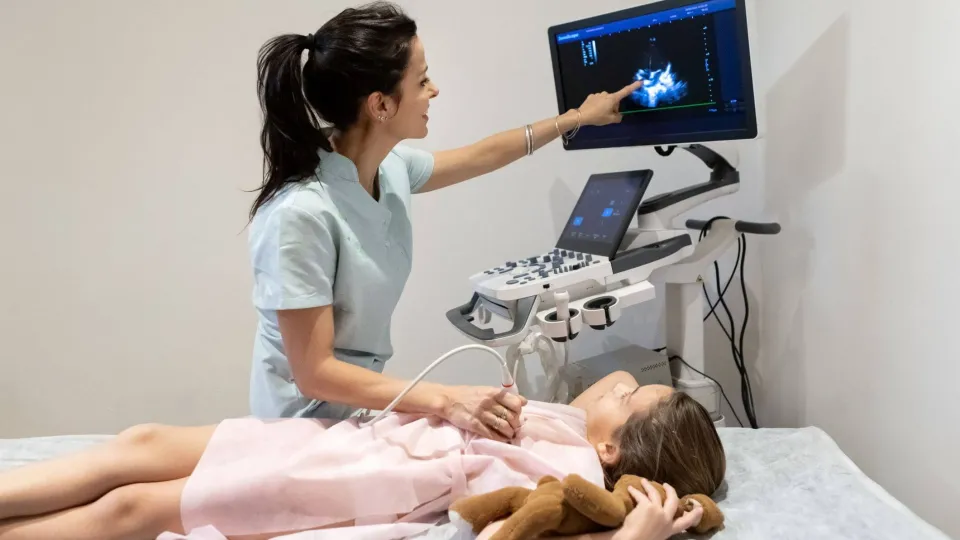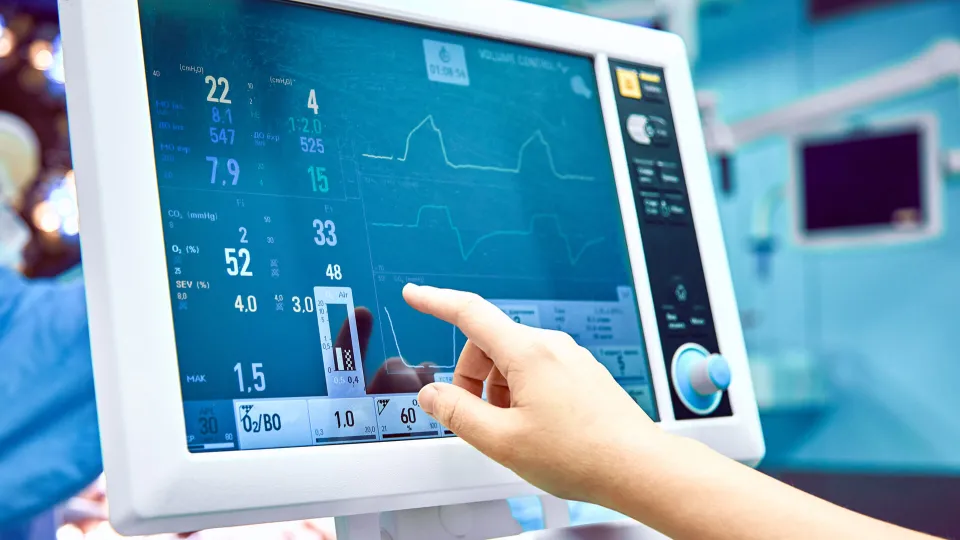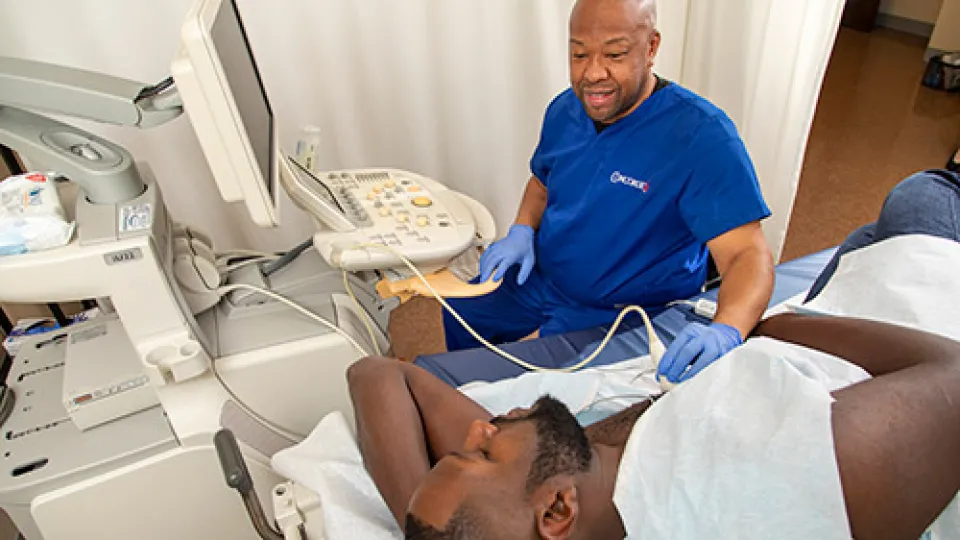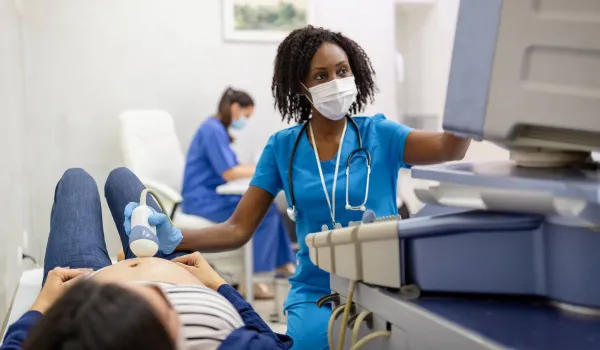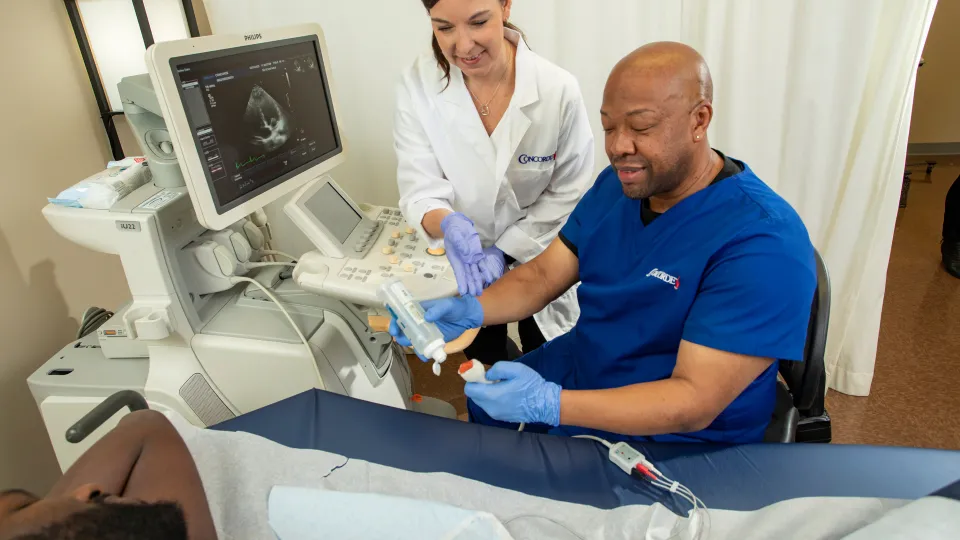
Echocardiography is the use of ultrasound waves to capture images of the heart's valves and chambers. An echocardiogram, also known as a heart sonogram or heart ultrasound, shows blood flow through the heart and its valves. This information helps health care providers diagnose and treat heart conditions.
Heart disease is the leading cause of death in the United States, accounting for 20% of all deaths. Over 83% of physicians believe echocardiograms are somewhat or entirely essential for patient management. Echocardiographers play an essential role in heart health care, providing the diagnostic results that physicians and specialists need to properly care for their patients.
What Is an Echocardiographer?

An echocardiographer, also known as a cardiac sonographer, cardiovascular ultrasound technologist, or cardiovascular sonographer or CVS, is a health care professional trained to perform echocardiograms, or echoes. These tests produce extensive information about the heart. They're most commonly used to rule out diagnoses, although they can also help physicians evaluate known conditions, assess acute changes, confirm suspicions, and inform health care decisions.
Echocardiographers typically work in hospitals, but some medical clinics, diagnostic imaging centers, and physicians' offices offer these tests as well, providing employment for echocardiographers on-site. The echocardiographer's job duties include:
- Reviewing the referring physician's instructions.
- Collecting patient information.
- Explaining the procedure to the patient.
- Preparing the patient for the echocardiogram.
- Performing echocardiogram tests as ordered by the referring doctor.
- Assessing the blood flow, valve function, and heart condition.
- Documenting test results.
- Assisting the physician with the diagnosis of heart conditions.
- Maintaining echocardiography equipment.
Related: The Different Types of Sonographers
Types of Echocardiograms
There are many different types of echocardiograms. A cardiac sonographer may specialize in a particular type of echocardiography or perform this test under a variety of conditions. The following are some of the echocardiograms that a physician may order.
Transthoracic Echocardiogram
A transthoracic echocardiogram is a standard heart ultrasound. This is typically the first echo a physician will order. The echocardiographer uses a handheld transducer and captures images from outside the body. A TTE can diagnose congenital heart defects, heart failure, and valve problems.
Transesophageal Echocardiogram
If the TTE fails to provide adequate information, a health care provider may order a transesophageal echocardiogram. This scan is performed from inside the body. A tiny ultrasound probe is inserted through the mouth and guided down the esophagus until it sits in the area directly behind the heart. From there, the ultrasound can capture more precise images of the heart. This test can diagnose cardiac tumors, stroke, and infective endocarditis.
Stress Echocardiogram
A stress echocardiogram includes two heart scans. The CVS takes images of the heart before and after physical exercise. This shows how the heart responds to the strain of physical stress or rigorous activity. Health care professionals usually do this test to diagnose coronary heart disease, offering a less invasive alternative to cardiac catheterization. If the patient can't perform physical activity, they may need to take medication that mimics the physical effects of exercise.
Fetal Echocardiogram
A fetal echocardiogram assesses the health of an unborn baby's heart. This is a noninvasive test that uses an ultrasound wand from outside the mother's body.
The echocardiographer can capture a two- or three-dimensional image of the heart, depending on the available technology. These images reveal the condition of the heart valves, heart walls, and major blood vessels. The ultrasound equipment also measures the Doppler signals produced as the sound waves reflect off the blood cells in the heart and blood vessels. This provides information on the direction and speed of the blood flow. Color flow imaging then converts this data into a color-coded visual representation.
Education and Training
You can earn the credentials required for a career as an echocardiographer by completing an associate degree program. Concorde Career College offers a Cardiovascular Sonography Associate Degree program that prepares students to pursue a career as a CVS. This 20-month program consists of 85.5 credit hours and 330 lab hours. Courses include instruction on how to conduct echocardiograms, evaluate test quality, record data, and produce reports for physicians and other health care providers. The curriculum for an echocardiographer also includes:
- Anatomy.
- Physiology.
- Cardiovascular terminology.
- Medical imaging.
- Sonographic principles and instrumentation.
- Medical terminology.
- Life sciences.
To excel as an echocardiography student, it's helpful to have an aptitude for science and math and a passion for health care. These professionals also need outstanding attention to detail, strong interpersonal skills, and both verbal and written communication skills.
Certification and Licensure

Only New Mexico and Oregon require licensure to work as a CVS. However, nearly all employers require certification. Some employers will give new graduates from an echocardiography program 12 to 24 months to obtain certification.
You can pursue certifications from the American Registry for Diagnostic Medical Sonography, Cardiovascular Credentialing International, or The American Registry of Radiologic Technologists. New Mexico and Oregon only accept certification from CCI or ARDMS. Options include:
- ARDMS Registered Diagnostic Cardiac Sonography with one of the following specialties:
- Adult Echocardiography.
- Fetal Echocardiography.
- Pediatric Echocardiography.
- CCI Certified Cardiographic Technician.
- CCI Registered Congenital Cardiac Sonography.
- CCI Registered Vascular Specialist.
- CCI Registered Cardiac Sonographer.
- ARRT Sonography certification.
You must pursue continuing medical education to maintain these certifications. To maintain ARDMS credentials, you need to complete 30 CME hours every three years. AART requires 24 CME hours every two years. To maintain a CCI registered-level credential, you must complete 36 CME credits, and certified-level credentials require 16 CME credits every three years.
Related: 10 Cardiovascular Tests to Know About
Career Outlook

According to the Bureau of Labor Statistics, the career outlook for diagnostic medical sonographers and cardiovascular technologists and technicians is exceptional, with an 11% increase in jobs projected over the 2023 to 2033 decade. This is nearly three times the national average of 4% for all jobs in the United States.
As the baby boomer generation ages, there will be a growing need for health care professionals who can serve their needs. In 2019, the incidence of cardiovascular disease was 35 to 40% among those ages 40 to 60, 77 to 80% among those ages 60 to 80, and over 85% in individuals over the age of 80.
While heart disease has traditionally been associated with older adults, there's growing concern about heart health in younger populations. Cardiovascular risk factors are on the rise in young adults. One study of individuals ages 20 to 44 found increased prevalence of hypertension, diabetes, and obesity between 2010 and 2020.
Echocardiography is a valuable tool for diagnosing and treating heart disease, and the use of this technology is rising alongside the incidence of cardiovascular deaths. The global echocardiography market value was $1.84 billion in 2023. It's projected to grow from $1.98 billion in 2024 to $3.48 billion by 2032, providing ample job security to the technologists who conduct these tests.
Advancements in Echocardiography
The field of echocardiology is constantly evolving. Interventional echocardiography is enhancing its application to support transcatheter aortic valve replacements by providing real-time visualization of the valves. This technology also allows surgeons to complete intricate valve replacements and repairs that might otherwise be impossible.
Three-dimensional echocardiography is becoming more accessible and provides detailed images of the heart, enhancing diagnostic capabilities and precision. The emerging 4D technology applies a live video effect to images to demonstrate blood flow and heart function. In the coming years, artificial intelligence will likely play a large role in the advancement of echocardiography by providing more sophisticated interpretations of echocardiograms.
Related: Trends in Cardiac Sonography and Diagnostic Imaging
Challenges and Opportunities in the Field
COVID-19 placed an unprecedented strain on echocardiographers. In performing essential diagnostics for the severe cardiovascular complications associated with the virus, exposure during the examination process increased the healthcare professionals' risk of infection. Post-COVID, the high demand for echocardiographers has created a significant workload for those in the field. In some areas, training programs have struggled to keep pace with the growing need for these professionals.
This is good news for echocardiographers entering the field, however, as it indicates an abundance of career opportunities. Research on cardiovascular magnetic resonance is on the rise. While only 500 papers were published on the topic in 1990, nearly 3,000 papers were released in 2018. Echocardiographers are poised at the forefront of this exciting field.
In Conclusion
Echocardiographers play an essential role in the health care field. From helping to identify the likelihood of an impending stroke to ensuring the heart health of unborn babies, an echocardiography career offers many opportunities to make a difference in the lives of others. You can start on the path toward your own career as a CVS with the Cardiovascular Sonography Associate Degree program from Concorde. Contact us to learn more today or apply now for the next program.
Related Concorde Spotlight: From Finance to Cardiovascular Sonography, Candace R., Concorde Alumni
“Heart Disease Facts.” CDC. https://www.cdc.gov/heart-disease/data-research/facts-stats/index.html
“Diagnostic and treatment utility of echocardiography in the management of the cardiac patient.” PubMed Central. https://www.ncbi.nlm.nih.gov/pmc/articles/PMC7383355/
https://www.bls.gov/ooh/healthcare/diagnostic-medical-sonographers.htm#tab-6
“Burden of cardiovascular disease among elderly: based on the Global Burden of Disease Study 2019.” Oxford Academic. https://academic.oup.com/ehjqcco/article/10/2/143/7193370
“Heart disease risk factors rise in young adults." Harvard Medical School. https://hms.harvard.edu/news/heart-disease-risk-factors-rise-young-adults
“Echocardiography Market Size, Share & Industry Analysis.” Fortune Business Insights. https://www.fortunebusinessinsights.com/echocardiography-market-105044
"Challenges and opportunities fear early career medical professionals in cardiovascular magnetic resonance (CMR imaging)". Journal of Cardiovascular Magnetic Resonance. https://jcmr-online.biomedcentral.com/articles/10.1186/s12968-023-00968-3
Take The Next Step Towards a Brighter Future
Interested in learning more about our Cardiovascular Sonography program?
We have a Concorde representative ready to talk about what matters most to you. Get answers about start dates, curriculum, financial aid, scholarships and more!

